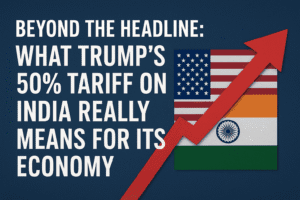Beyond the Headline: What Trump’s 50% Tariff on India Really Means for Its Economy
The Trump administration’s imposition of 25% additional tariffs on India, effective August 2025, raises total duties on key exports to a punishing 50% or higher. This move disproportionately threatens India’s micro, small, and medium enterprises (MSMEs), which form the backbone of its export economy. Sectors like gems and jewellery, textiles, and seafood face an immediate crisis, as their high US market exposure and thin profit margins leave them vulnerable. Indian exporters will struggle to compete against rivals from Vietnam, Bangladesh, and Ecuador, who benefit from significantly lower tariffs.
While the domestic market may offer some cushion and pharmaceuticals remain exempt, the tariffs jeopardize crucial revenue and employment in major industrial clusters like Surat and Tirupur. Ultimately, this policy risks permanently altering supply chains and poses a severe challenge to the livelihoods within India’s export-dependent communities.

Beyond the Headline: What Trump’s 50% Tariff on India Really Means for Its Economy
The recent announcement from the Trump administration, imposing a sweeping 25% additional tariff on Indian goods effective August 27, 2025, is more than a political headline. It represents a severe escalation in trade relations, pushing total duties on key Indian exports to a staggering 50% or higher. This move places India among the most heavily tariffed major US trading partners, triggering urgent concerns about the resilience of key Indian industries and the millions of jobs they support.
While the political rhetoric focuses on “strategic defiance,” the on-the-ground impact will be felt most acutely by Micro, Small, and Medium Enterprises (MSMEs)—the backbone of India’s export ecosystem.
The Core of the Crisis: MSMEs in the Crosshairs
Analysts from CRISIL highlight a critical vulnerability: MSMEs account for roughly 45% of India’s total exports. These businesses operate on thin margins and lack the deep financial reserves of large corporations to absorb sudden cost shocks. The new tariffs don’t just make their products more expensive; they threaten to price them out of the market entirely against competitors from nations with more favorable trade terms.
“The playing field is about to become profoundly uneven,” explains a trade analyst. “Partial absorption of these new costs will squeeze their already-slim margins, posing a material challenge to their competitiveness and survival.”
Sector-by-Sector Breakdown: The Winners, Losers, and Most Vulnerable
The impact is not uniform. Some sectors are shielded, while others face an existential threat.
The Most Impacted:
- Gems & Jewellery (~$10B in exports to US): This is India’s single largest exposure. The diamond polishing hub of Surat, which controls over 80% of exports, is directly in the firing line. With the US accounting for a third of all Indian diamond exports, a 52.1% duty will make it incredibly difficult to compete. The potential silver lining? Soaring global gold prices might mask the full revenue impact, but volumes are almost certain to contract.
- Textiles & Apparel (~$10.8B in exports to US): This is a disaster for clusters like Tiruppur (known as “India’s knitwear capital”). A duty as high as 63.9% eviscerates India’s cost advantage. Compare this to the 31% duty faced by rivals in Bangladesh and Vietnam, and the scale of the problem becomes clear. Buyers will inevitably shift orders elsewhere, risking significant employment in major hubs like Tiruppur, the National Capital Region (NCR), and Bengaluru.
- Seafood (~$2.4B in exports to US): The US is a critical market for Indian shrimp, taking about 32% of its exports. Now facing total duties of 60%, exporters in states like Andhra Pradesh are at a severe disadvantage against competitors like Ecuador, which benefits from geographic proximity and a mere 15% tariff.
Significantly Challenged:
- Automotive Components ($3.4B facing 25% duty): While the US market is only 3.5% of India’s total production, the pain will be concentrated. SMEs supplying gearbox and transmission components—which have a 40% exposure to the US—will be hard hit as larger exporters adjust their supply chains.
- Chemicals & Agriculture: The chemical sector faces stiff competition from Japanese and Korean firms with lower tariffs. Agricultural exports, including prized Basmati rice, spices, and tea (worth ~$6B), now face 50% duties, potentially ceding market share to Pakistan and Thailand.
The Sheltered Sectors:
Not all is doom and gloom. One major victory for India is that pharmaceuticals, which constitute 12% of its US-bound exports, remain untouched by these new tariffs. This protects a critical and high-value industry from immediate harm.
The Silver Lining and the Path Forward
There is a mitigating factor. CRISIL notes that a projected $10 billion growth in the domestic market for these affected sectors could partially absorb the shock and provide a cushion for some businesses. However, this is cold comfort for export-oriented MSMEs.
The broader implication is a strategic recalibration of global supply chains. US importers, seeking to avoid these punitive costs, will increasingly look to alternatives in Mexico, Europe, Vietnam, and Bangladesh. Regaining that lost market share, even if tariffs are reduced in the future, will be an uphill battle.
The Human Impact:
Ultimately, this is a story about people. It’s about the diamond polisher in Surat, the garment worker in Tiruppur, and the shrimp farmer in Visakhapatnam. The true cost of these tariffs will be measured in jobs threatened and livelihoods disrupted. The resilience of these MSMEs and the strategic response from New Delhi will determine whether India can navigate this profound trade challenge or if its export engine will be forced into a painful and costly detour.
You must be logged in to post a comment.